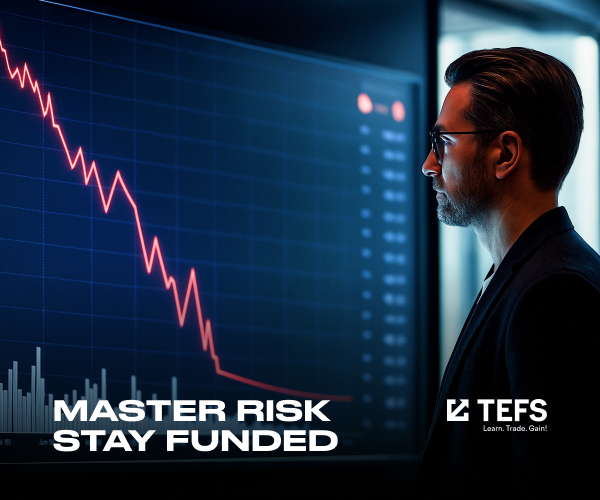Understanding Max Drawdown

✅ Understanding Max Drawdown at TEFS: A Simple Guide for Traders
If you're participating in a prop firm challenge or funded account at TEFS, the Max Drawdown limit is one of the most essential rules you'll need to follow. This rule is designed to protect both you and the firm's capital — and it's a key part of managing risk like a professional trader.
In this guide, we'll explain Max Drawdown, how it works with our static drawdown model, and how you can stay within the limits while building consistent profits.
📌 What Is Max Drawdown?
Max Drawdown is the maximum loss you can take during your trading challenge or funded account period. Think of it as an account-wide stop-loss. Your account will be closed or disqualified if your total losses ever reach this limit.
At TEFS, we use a static drawdown model, which means your drawdown limit is fixed and based on your starting account balance. It doesn’t move, even if your account grows.
📊 Static vs. Trailing Max Drawdown (And Why Static Is Better)
Here’s a quick breakdown of the difference:
🔒 Static Max Drawdown (Used at TEFS)
● Your drawdown limit has been fixed since day one.
● It’s based on your initial account balance.
● It does not increase or adjust as your balance grows.
Example:
Start with $100,000.
10% Max Drawdown = $90,000 floor.
Your account equity can never drop below $90,000 — no matter how high your profits go.
✅ This gives you more flexibility and reduces pressure to protect every gain.
📉 Trailing Max Drawdown (Used by Some Other Firms)
● Your loss limit moves up as your account grows.
● It’s tied to your highest balance or equity during the day.
● It shrinks your buffer as you make profits.
Example:
You grow from $100,000 to $105,000.
Now your 10% Max Drawdown is based on $105,000 → Your new limit is $94,500.
❗ This model can punish you for giving back gains, even if you’re still profitable.
🧮 How Is Static Max Drawdown Calculated at TEFS?
The calculation is simple:
Max Drawdown = Starting Balance × Drawdown %
If you start with a $400,000 account and have a 10% Max Drawdown, your total loss limit is:
📉 $400,000 × 10% = $40,000
You can’t let your account equity drop below $360,000, even from floating (open) losses.
⚠️ What Counts Toward the Drawdown?
Your account equity is what matters, not just your closed trades. The following are included:
● ✅ Realized losses (from trades you've closed)
● ✅ Unrealized losses (from trades still open)
● ✅ Commissions and swaps
So even if you haven’t closed a losing trade, those floating losses still count toward your Max Drawdown.
🔄 Can You Recover After Taking a Loss?
Yes — and this is one of the most significant advantages of trading with a static drawdown at TEFS.
With a static drawdown, your loss limit is based on your original starting balance, and it doesn’t move, even if your account grows. If you take a loss early on, you still have room to recover by making profitable trades later.
✅ Here's how it works:
Let’s say you start with a $100,000 account with a 10% max drawdown. That means your account can’t drop below $90,000.
● You take a loss of $8,000 → Your account is now at $92,000.
● A few days later, you profit from $5,000 → Your account is now at $97,000.
That profit brings you further away from the $90,000 drawdown limit. So even though you were down earlier, your recovery gives you more space to trade again.
🧠 Why this matters:
● You’re not punished for giving back gains like in a trailing drawdown model.
● Profits help reduce your risk of hitting the limit.
● It encourages smart, consistent trading instead of emotional reactions.
As long as you stay above the drawdown threshold, you can always bounce back and continue progressing through the challenge.
⛔ What Happens If You Hit Your Max Drawdown?
If your account equity drops to or below the maximum drawdown limit, your account will be closed immediately — regardless of whether the loss happened from one large trade or multiple smaller ones.
This rule applies to both evaluation challenges and funded accounts at TEFS.
● During a challenge, this means you will fail the evaluation and need to purchase a new challenge account if you wish to try again.
● In a funded account, hitting the max drawdown results in loss of the account.
This strict rule is in place to enforce disciplined risk management and protect trading capital — both yours and the firm's.
🎯 Why TEFS Uses the Static Max Drawdown Rule
We designed our rules to support safe, disciplined, and realistic trading. Here’s why this rule matters:
● 🔐 Protects firm capital
● 📘 Teaches real-world risk management
● 🧠 Promotes consistency over gambling
● 💪 Builds trader discipline for long-term success
💡 Tips to Stay Within Your Drawdown Limit
Trading within your drawdown doesn’t have to be stressful. Here are some best practices:
1. Know Your Limit
Keep your drawdown threshold in mind at all times. For a $100,000 account with a 10% Max Drawdown, your minimum allowed equity is $90,000.
2. Watch Your Equity — Not Just Your Balance
Floating losses count. Always track your live equity, especially when you have open trades.
3. Respect Your Daily Drawdown
At TEFS, we also enforce a Daily Max Drawdown (e.g., 4%). This rule applies only to Challenges and resets each trading day at midnight (00:00) New York time. It helps protect your account from large single-day losses and encourages disciplined risk management.
👉 Learn more about the Max Daily Drawdown in prop trading
4. Use Stop-Losses
Don’t leave trades open without protection. A single move could push your equity below the drawdown limit.
📈 Final Thoughts
Max Drawdown is not just a rule — it’s a tool. It protects your trading capital and keeps you focused on managing risk, not chasing unrealistic gains.
At TEFS, we use a static drawdown model because we believe it gives traders the fairest chance to succeed. By understanding how it works and respecting the limits, you’ll set yourself up for long-term success — and a funded trading future.
Ready to prove your skills and trade real capital with clear, fair rules?
👉 Explore TEFS Evaluation Programs and start your journey today.


 Русский
Русский  Español
Español  Deutsch
Deutsch  Indonesian
Indonesian  Português
Português  Français
Français  Nederlands
Nederlands  Italiano
Italiano  中文
中文  عربي
عربي  Türkçe
Türkçe 

